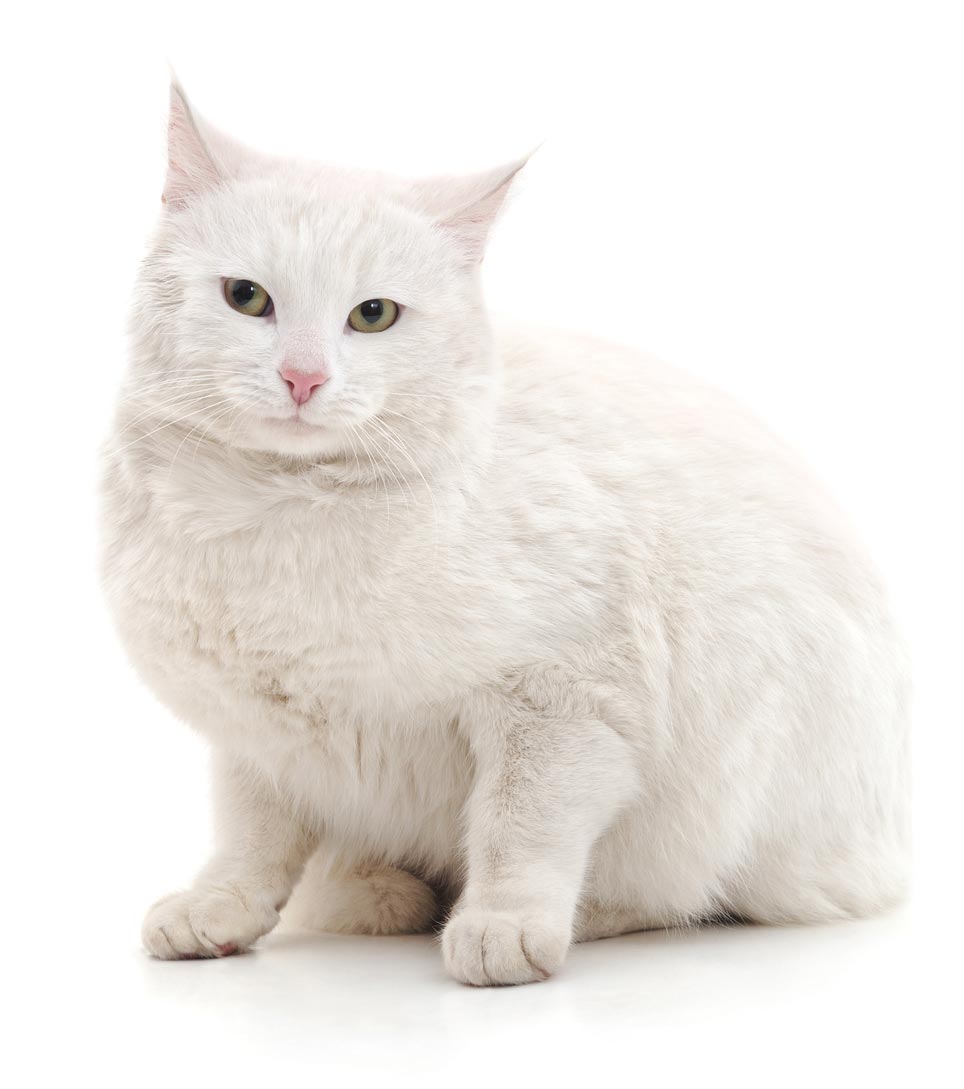Feline Diabetes Mellitus
 Diabetes mellitus is a complex disorder that is not uncommon in cats (about 1 in 200 cats are affected). Diabetes mellitus is a single process, but the underlying reasons it develops vary, and the effects on the body are many. If undiagnosed, it can lead to serious illness and even death.
Diabetes mellitus is a complex disorder that is not uncommon in cats (about 1 in 200 cats are affected). Diabetes mellitus is a single process, but the underlying reasons it develops vary, and the effects on the body are many. If undiagnosed, it can lead to serious illness and even death.
Insulin is the hormone that is affected in this disease. Insulin not only affects sugar processing in the body, it also has an impact on protein and fat processing. This means that many parts of body metabolism are affected by diabetes.
How Insulin Works in a Cat's Body
To understand diabetes, it is necessary to have an understanding of how insulin works in the body. After a meal, insulin is secreted from the pancreas to help the body’s tissues take up nutrients. If there is insufficient release of insulin or if the tissues are not responding to the insulin, processing of nutrients is abnormal. Glucose remains in the bloodstream rather than being used. This, in part, results in cell starvation and is a part of the disease we call diabetes. Cats are different from people and dogs in that their pancreas responds to amino acids, not glucose, for regulation of insulin release. In humans, the two most common types of abnormalities that lead to diabetes are classified according to this scheme:
- Type I: Absolute Insulin Deficiency: This is juvenile onset, or insulin dependent diabetes mellitus (IDDM), in humans. It results in low blood insulin concentrations due to impaired insulin secretion from the pancreas because of destruction of insulin producing cells (immune system sees the cells as foreign). Treatment requires insulin injections.
- Type II: Functional Insulin Deficiency: This is non-insulin dependent diabetes (NIDDM), or peripheral insulin resistance, in humans, which revolves around tissues in the body that have stopped recognizing the insulin. It is more likely that type II diabetes can be managed with dietary therapy or oral medication (oral hypoglycemics).
The majority of cats have insulin (type II) resistance, which means that the tissues ignore insulin signals. A chronic, mild state of hyperglycemia (excess glucose in the blood stream) is an early sign. Over time, pancreas cells may lose some or all of their ability to produce any insulin, leading to type I (insulin dependent) diabetes. Therefore, although some cats in the early stages of the disease may not require insulin therapy, by the time the owner detects the disease and the veterinarian is consulted, the disease has sometimes progressed to type I diabetes, and the cat is unable to produce enough insulin on his own.
Which Cats Are at Risk of Developing Diabetes?
Any age or sex of cat may become affected by diabetes, although most cats are over ten years of age when the disease is diagnosed. The most common risk factors for diabetes in cats are obesity, pancreatitis (an inflammatory disease of the pancreas), and a genetic predisposition (Burmese cats may be at higher risk) to the disease. The use of some drugs, such as steroids, may also increase the risk of a cat developing diabetes.
Of these, obesity is thought to be the most important feline risk factor for diabetes, and it is one of the few risk factors that is under the owner’s control.
Signs of Diabetes in Cats
Most cats with diabetes have increased thirst and urine production, decreased appetite, depression, and an unkempt coat. Sudden or gradual weight loss may also occur. Two of the most common complaints from owners is that their cats are urinating outside the litter box or that a once hearty eater is now picking at his food.
Diagnosis of Diabetes in Cats
If the veterinarian suspects diabetes mellitus, blood and urine samples will be taken. The blood is tested for the level of glucose, and the urine is tested for the presence of glucose, ketones, and infection. Some cats may become very anxious at the time the blood sample is taken and may develop “ stress-induced hyperglycemia”. This is an elevation of blood glucose caused by stress rather than diabetes. This can make interpretation of results a challenge, so if there is any doubt, an additional sample of blood will be sent to a laboratory to run a fructosamine concentration. A high level of fructosamine means that there are persistent high sugar levels in the cat, and this will help confirm the diagnosis.
Complications of Diabetes in Cats
Once the cells cannot take glucose and other key nutrients into the tissues, there is an increased delivery of fatty acids to the liver, which subsequently produces “ketone bodies” this can rarely result in a state known as diabetic ketoacidosis. This is an unusual complication, but is life-threatening. As the complication progresses, dehydration, vomiting, increased respiratory rate, coma, and possibly death may all be consequences. The liver becomes fatty, and in an obese cat, this can be a difficult complication to manage all on its own.
Cataracts are a common complication of diabetes in people and dogs, but they are less common in cats.
Diabetic neuropathy, a condition where there is reduced nerve function, is also sometimes seen, and development of a dropped hind limb stance, termed a “plantigrade stance” is a common sign of this problem. The cat literally walks on his hocks.
Note that the female hormones can adversely affect diabetes, so once she is stable, it is best to have a diabetic female cat spayed.
Treatment of Feline Diabetes
Many type II diabetic cats will respond to dietary changes—a low carbohydrate, high protein diet will allow adequate control for about 58% of cats. Of those still requiring insulin injections, being on this type of diet will help lower the dose of insulin needed to obtain control.
Chromium is a dietary supplement that may favor normalization of metabolism and is sometimes added into the regimen.
Oral hypoglycemics are a class of drug often used for human diabetics. In cats, these drugs have variable efficacy and it can take up to a month to see improvement. A portion of cats do not respond and need insulin for relief.
Most cats require longer acting insulin formulations, and sometimes, dose or formulation source may have to be adjusted before good control is achieved. A newer type of insulin called glargine is being used in a limited fashion but is not licensed for use in cats yet.
Canned food is preferable to kibbles since making the kibble requires additional carbohydrates. Specific diets formulated by Hill's Pet Nutrition and Purina, for example, provide excellent balance of protein and carbodydrates for afflicted cats.
Home monitoring of diabetic cats can be tailored to meet the needs of the particular patient, but recent evidence shows that using a small ear prick and a human glucose meter provides excellent blood glucose readings since the cat is less stressed in the home environment.
Make sure you know what to do if you administer insulin and the cat becomes weak and perhaps even collapses or has seizures. This can indicate low blood sugar and is an emergency. Karo syrup on the gums and a prompt trip to the veterinarian are indicated.
With proper care, a diabetic cat can live a relatively normal life.
You May Also Like These Articles:
Subcutaneous Fluid Therapy: Giving Your Cat Fluids at Home
Flame Retardants and Hyperthyroidism in Cats
Why Should I Take My Cat to the Vet?
How To Take Your Cat To The Vet
Notice: Ask-a-Vet is an affiliated service for those who wish to speak with a veterinary professional about their pet's specific condition. Initially, a bot will ask questions to determine the general nature of your concern. Then, you will be transferred to a human. There is a charge for the service if you choose to connect to a veterinarian. Ask-a-Vet is not manned by the staff or owners of CatHealth.com, and the advice given should not delay or replace a visit to your veterinarian.






